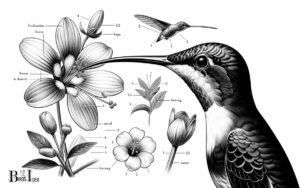Rufous Vs Broad Tailed Hummingbird: Comparison!
The Rufous Hummingbird and the Broad-tailed Hummingbird are two distinct species that can be differentiated by their physical characteristics, behaviors, and habitats.
The Rufous Hummingbird, known for its striking rufous or orange plumage, is smaller and more aggressive, often dominating feeding areas.
The Broad-tailed Hummingbird, however, displays a more subdued green coloration and has a distinct trill sound produced by its wings during flight.
To distinguish between a Rufous and a Broad-tailed Hummingbird, consider the following:
For example, if you hear a distinct wing-trill and see a larger hummingbird with a greenish back, it’s likely a Broad-tailed Hummingbird. Conversely, a smaller, orange hummingbird displaying territorial behavior is probably a Rufous Hummingbird.
The enchanting world of hummingbirds captivates bird enthusiasts, with the feisty Rufous and the trilling Broad-tailed species offering distinct glimpses into the diversity of these avian jewels.

Key Takeaway
Physical Differences
How do the physical characteristics of the Rufous and Broad Tailed Hummingbirds differ?
The Rufous Hummingbird (Selasphorus rufus) is renowned for its vibrant orange-red plumage on the throat, while the Broad Tailed Hummingbird (Selasphorus platycercus) exhibits a striking rosy-pink gorget.
In terms of size, the Rufous Hummingbird is slightly smaller, with an average length of 8 centimeters, compared to the Broad Tailed Hummingbird which measures around 10 centimeters.
Additionally, the Rufous Hummingbird has a more slender and slightly curved bill, whereas the Broad Tailed Hummingbird possesses a shorter and straighter bill.
These physical distinctions between the two species are crucial for identification and provide insight into their respective ecological adaptations.
Feeding Behavior
The Rufous Hummingbird and the Broad Tailed Hummingbird both exhibit distinct feeding behaviors.
- Feeding Technique: Rufous Hummingbirds primarily use traplining, visiting a sequence of flowers in a consistent route, whereas Broad Tailed Hummingbirds are known to defend territories around abundant food sources.
- Diet Composition: Rufous Hummingbirds consume a diverse diet, including nectar, insects, and sap, while Broad Tailed Hummingbirds rely mainly on nectar and occasionally consume small insects.
- Feeding Preferences: Rufous Hummingbirds are more prone to aggressive behavior at feeders and often prefer tubular flowers, while Broad Tailed Hummingbirds are known for their aerial displays and favor flowers with open blooms.
These feeding behaviors highlight the specialized adaptations of each species, allowing them to thrive in their respective habitats.
Migration Patterns
During migration, both the Rufous Hummingbird and the Broad Tailed Hummingbird undertake impressive long-distance journeys to reach their breeding and wintering grounds.
The Rufous Hummingbird is known for one of the longest migratory journeys of any bird, traveling up to 3,000 miles from its breeding grounds in North America to its wintering grounds in Mexico and Central America.
In comparison, the Broad Tailed Hummingbird migrates from its breeding grounds in western North America to its wintering grounds in Mexico.
Both species time their migrations to coincide with the blooming of flowers along their routes, ensuring a steady supply of nectar for fuel. This synchronization speaks to their remarkable adaptation to their environments.
Understanding their migration patterns provides valuable insight into their ecological needs and the challenges they face during these arduous journeys.
Vocalizations
The vocalizations of Rufous and Broad-Tailed Hummingbirds exhibit differences in pitch and frequency, which play a significant role in their communication and mating behaviors.
While both species use distinctive call patterns, their specific vocalizations serve varying purposes in their social interactions and territorial defense.
Understanding the nuances of their vocalizations can provide valuable insights into the behavioral ecology and evolutionary adaptations of these two hummingbird species.
Pitch and Frequency
In the vocalizations of Rufous and Broad Tailed Hummingbirds, the pitch and frequency differ significantly, reflecting their distinct communication strategies and social behaviors.
Rufous Hummingbird:
- The vocalizations of Rufous Hummingbirds are characterized by a higher pitch and frequency, often reaching up to 8 kHz.
- Their calls are sharp and piercing, suited for long-range communication in open environments.
- The high-pitched vocalizations are also used in territorial defense and courtship displays.
Broad Tailed Hummingbird:
- Broad Tailed Hummingbirds produce vocalizations with a lower pitch and frequency, usually ranging between 2-4 kHz.
- Their calls are more melodious and include trills and chatters, ideal for communication in densely vegetated areas.
- The lower frequency calls are effective for close-range communication and maintaining social cohesion within their habitat.
Communication and Mating
Communication and mating in Rufous and Broad Tailed Hummingbirds is influenced by their distinct vocalizations, with each species employing specific pitches and frequencies tailored to their social behaviors and environmental adaptations.
Rufous hummingbirds produce a series of high-pitched squeaks and chips, often in rapid succession, during courtship displays and to establish territory. These vocalizations are essential for attracting mates and deterring rivals.
On the other hand, Broad Tailed Hummingbirds emit a softer, lower-pitched “peent” sound during courtship, which is often accompanied by aerial displays.
These distinct vocalizations are crucial for species recognition and mate attraction within their respective environments.
The differences in vocalizations reflect the unique mating and social behaviors of these two hummingbird species, demonstrating their remarkable adaptations to their ecological niches.
Distinctive Call Patterns
During courtship and territorial displays, Rufous and Broad Tailed Hummingbirds exhibit distinctive call patterns, reflecting their specific social behaviors and environmental adaptations.
Rufous Hummingbirds:
- Emit sharp metallic “tik” calls during aggressive interactions, signaling territorial defense.
- Produce a rapid series of “tzep” or “chip” notes during courtship displays, attracting potential mates.
- Have a high-pitched “tseep” call used in flight to communicate with other hummingbirds.
Broad Tailed Hummingbirds:
- Utter a soft “chewp” call during territorial disputes, often accompanied by aerial acrobatics.
- Emit a prolonged and buzzy “zeeee” call during courtship flights, creating a distinctive sound.
- Use a lower-pitched “tew” call to communicate with conspecifics during foraging or perching.
These unique call patterns play a crucial role in the communication and social dynamics of each species.
Nesting Habits
The nesting habits of the Rufous and Broad Tailed hummingbirds differ in several aspects. These include their preferences for nesting materials and the locations where they choose to build their nests.
Understanding these differences can provide valuable insight into the behaviors and ecological requirements of these two hummingbird species.
Nesting Material Preferences
The Rufous and Broad-tailed hummingbird’s nesting material preferences signify their adaptability to different environments and nesting habits.
Rufous Hummingbird
- Prefers using moss, lichen, and plant fibers to construct its nest.
- Often incorporates spider silk to bind nesting materials together, providing elasticity and strength to withstand harsh weather conditions.
- Adaptable to using human-made materials such as cotton, wool, or string when natural resources are scarce.
Broad-tailed Hummingbird
- Shows a preference for using plant down, feathers, and grass in nest construction.
- Tightly weaves its nest with the selected materials, providing insulation and protection for the eggs and nestlings.
- Known to incorporate animal hair or fur into the nest structure for added warmth and camouflage.
These distinct material preferences reflect the hummingbirds’ ability to adapt to diverse ecological niches and environmental conditions.
Nest Location Differences
Nesting Habits’ Nest Location Differences Reflect the Rufous and Broad-tailed Hummingbird’s Diverse Ecological Adaptations. Both species exhibit distinct preferences in nest locations, aligning with their respective habitats and ecological needs.
| Nest Location | Rufous Hummingbird | Broad-tailed Hummingbird |
|---|---|---|
| Elevation | Higher elevations, up to 12,000 feet in coniferous | Lower elevations, typically below 9,000 feet in |
| forests | mountain meadows and shrublands | |
| Nest Attachment | Placed on coniferous trees, often near water sources | Attached to branches, often in deciduous trees |
| Nest Structure | Compact cup-shaped structure | Elongated and more open cup-shaped structure |
| Camouflage | Often well-camouflaged due to the environment | Less camouflage due to the open habitat |
These differences in nest locations showcase the adaptability of these hummingbirds to their specific environments, highlighting the intricate relationship between these avian species and their ecological niches.
Range and Habitat
Both the Rufous and Broad-tailed hummingbirds occupy distinct ranges and habitats across North America.
Rufous Hummingbird:
- Range: Found in the western United States, from Alaska to California, and as far east as western Montana. They also migrate to Mexico and Central America during the winter.
- Habitat: Prefers open areas, including mountain meadows, shrubby areas, and gardens, often at higher elevations.
- Broad-tailed Hummingbird:
- Range: Inhabits the mountainous regions of the western United States, from Wyoming and Idaho to Arizona and New Mexico.
- Habitat: Often found in montane forests, aspen groves, and canyons, typically at elevations between 6,000 and 10,000 feet.
Both species have adapted to specific ecological niches within their ranges, optimizing their survival.
Conservation Status
Despite their distinct habitat preferences, the conservation status of the Rufous and Broad-tailed hummingbirds is a matter of concern across their respective ranges.
The Rufous hummingbird (Selasphorus rufus) has a status of “Least Concern” on the IUCN Red List, indicating a relatively low immediate threat of extinction.
However, climate change and habitat loss due to deforestation and urbanization are potential long-term concerns.
On the other hand, the Broad-tailed hummingbird (Selasphorus platycercus) also holds a “Least Concern” status, but faces similar threats.
Both species rely on nectar from specific flowers and are sensitive to environmental changes.
Conservation efforts focusing on preserving their critical habitats, ensuring the availability of nectar sources, and mitigating the effects of climate change are essential for the long-term survival of these magnificent birds.
Conclusion
The rufous and broad-tailed hummingbirds exhibit distinct physical differences, feeding behaviors, migration patterns, vocalizations, nesting habits, and range and habitat preferences.
While the rufous hummingbird is known for its fiery orange plumage and aggressive nature, the broad-tailed hummingbird is recognized for its iridescent green feathers and melodious vocalizations.
Both species play vital roles in their respective ecosystems, contributing to the beauty and biodiversity of their habitats.






